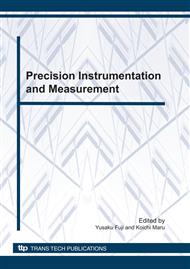p.405
p.413
p.422
p.430
p.436
p.442
p.451
p.458
p.466
Active Damping Using N4SID Model Referenced Predictive Anti-Phase Pitch Driving Method
Abstract:
Vibration suppression control considering elastic part deformation is one of the indispensable issues in the precision engineering field and a high-density LSI circuit processing[1]. This study aims at suppressing the induced vibration at rapid positioning operation using the N4SID (Subspace State Space model Identification) Model Referenced predictive Anti-phase pitch Driving Active Damping (N4SID-MRAD) and improve the positioning performance limit generated by conventional PID feedback control with existing actuator, which has low dynamic characteristics with a time lag. This control method consists of reduced order model identification (model order reduction using N4SID concept: offline process) and predictive control using the counter pitch driving based on the model output (: on-line process). This method was applied to principal axis vibration suppression of three axes positioning machine driven by a ball screw feeding mechanism to control the probe tip end positioning in feeding rod axis. The result showed that amplitude of residual vibration at the probe tip end suppressed with conventional PI controlled and the 77% performance improvement under low stable conditions that Balanced Realization could not be applied.
Info:
Periodical:
Pages:
436-441
Citation:
Online since:
October 2010
Authors:
Keywords:
Price:
Сopyright:
© 2010 Trans Tech Publications Ltd. All Rights Reserved
Share:
Citation:


